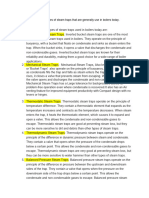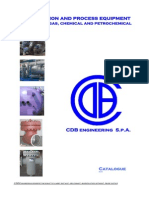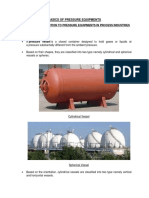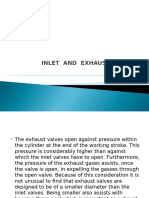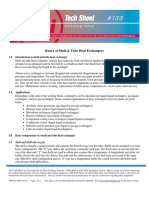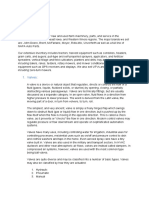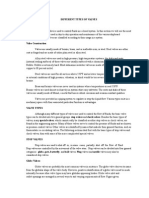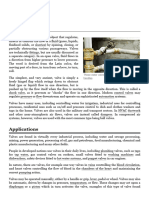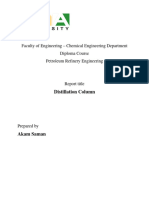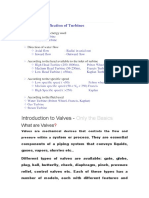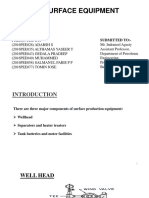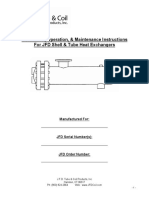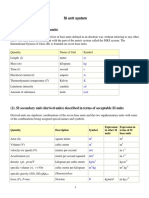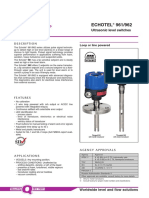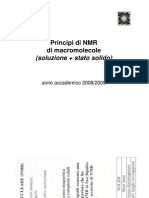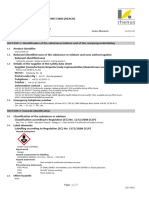Steam Traps - Operating Principles and Types: Tech Sheet #ST 107
Steam Traps - Operating Principles and Types: Tech Sheet #ST 107
Uploaded by
Awais NaseerCopyright:
Available Formats
Steam Traps - Operating Principles and Types: Tech Sheet #ST 107
Steam Traps - Operating Principles and Types: Tech Sheet #ST 107
Uploaded by
Awais NaseerOriginal Title
Copyright
Available Formats
Share this document
Did you find this document useful?
Is this content inappropriate?
Copyright:
Available Formats
Steam Traps - Operating Principles and Types: Tech Sheet #ST 107
Steam Traps - Operating Principles and Types: Tech Sheet #ST 107
Uploaded by
Awais NaseerCopyright:
Available Formats
Tech Sheet #ST 107
Steam Traps Operating Principles and Types
STEAM TRAPS: Steam Traps are automatic valves designed to remove condensate from steam lines, but prevent steam loss by trapping the steam; hence the name, Steam Trap. Air is usually present for some period of time in a steam line, either during start-up and/or operation. So, depending on the application, air is another fluid that usually requires removal from a steam line. Therefore, in order to operate properly, steam traps should be able to sense certain differences between condensate, steam, and air. Based on current designs, there are three basic operating principles of steam traps, which are explained below: Thermostatic, Density, and Thermodynamic. THREE OPERATING PRINCIPLES OF STEAM TRAPS: THERMOSTATIC traps sense the temperature difference of entering fluids These are designed to open for cool fluid and close for hot fluid. The intention is to open for cool condensate or air, and close for hot condensate. The closure occurs when the fluid, typically hot condensate, has a temperature greater than or equal to a certain threshold value. The hot temperature causes a thermostatic element to move in such a manner that closes a valve head against a valve seat (valve). This temperature threshold value is below that of saturated steam, but the actual specific temperature to open/close is different depending on the type of thermostatic trap. Since air like cool condensate has a temperature significantly lower than steam, thermostatic traps are generally very good at venting large amounts of air. There are three basic types of thermostatic traps that operate according to the temperature principle: Expansion, Balanced Pressure, and Bi-Metal. Expansion trap elements have an internal filling that expands and contracts with temperature change to actuate the valve, but the filling does not vaporize. There are two basic element designs: wax or petroleum-based liquid: o o Wax elements are in a congealed state when cool, and expand when heated Petroleum-based elements are in a contracted liquid state when cool, and expand when heated
This Tech Sheet was developed by the members of the Fluid Controls Institute (FCI) Steam Trap Section. FCI is a trade association comprising the leading manufacturers of fluid control and conditioning equipment. FCI Tech Sheets are information tools and should not be used as substitutes for instructions from individual manufacturers. Always consult with individual manufacturers for specific instructions regarding their equipment. 4/2/08 Page 1 of 5 This sheet is reviewed periodically and may be updated. Visit www.fluidcontrolsinstitute.org for the latest version.
Tech Sheet #ST 107
Balanced Pressure trap elements have filling which is a mixture of water and mineral spirits that generally vaporizes or condenses at near-to-steam temperature to actuate the valve. There are five basic element designs: drum or barrel, spiral bellows, edge-welded bellows, encapsulated bellows, and encapsulated diaphragms. o o o o o Drum or Barrel elements are of cylindrical design with soldered ends, usually constructed of copper Spiral Bellows elements are of convoluted tube design with soldered ends, usually constructed of copper or monel Edge-Welded elements are constructed of alternating inner and outer welds to join stainless steel plates Encapsulated Bellows elements are constructed of stainless steel plates; enclosed in a protective stainless steel outer shell Encapsulated Diaphragm elements are constructed of either stainless steel or Hastelloy-equivalent diaphragms; enclosed in a protective stainless steel outer shell
Bi-Metal trap elements are composed of two dissimilar metal strips bonded together so that temperature change causes deflection in one direction or its opposite to actuate the valve. There are four basic element designs: Circular Plate, Irregular Plate, Cantilever Strip, and Single Strip. o Circular Plate elements contain stacked circular discs, centrally surrounding a valve stem. The stacked orientation of the plates is alternating, so that the metal of one disc faces the same metal on the next. Temperature change causes deflection of the opposed discs to actuate the valve open and closed. Irregular Plate elements contain stacked plates of irregular, but identical shape, centrally surrounding a valve stem. The stacked orientation of the plates is alternating, so that the metal of one plate faces the same metal on the next. Temperature change causes deflection of the opposed plates to actuate the valve open and closed. Cantilever Strip elements contain identical, rectangular-shape, bimetal strips stacked on top of each other. The stack is attached to a fixed mounting point at one end, and surrounding a valve stem at the other. The strips are stacked in like orientation, so that metal of one strip faces the dissimilar metal on the next. Temperature change causes stack deflection to actuate the valve open and closed. Single Strip elements contain a single bimetal strip bent into the basic shape of an upper case C, with the two ends surrounding a valve stem. Temperature change causes deflection of the strip to actuate the valve open and closed.
This Tech Sheet was developed by the members of the Fluid Controls Institute (FCI) Steam Trap Section. FCI is a trade association comprising the leading manufacturers of fluid control and conditioning equipment. FCI Tech Sheets are information tools and should not be used as substitutes for instructions from individual manufacturers. Always consult with individual manufacturers for specific instructions regarding their equipment. 4/2/08 Page 2 of 5 This sheet is reviewed periodically and may be updated. Visit www.fluidcontrolsinstitute.org for the latest version.
Tech Sheet #ST 107
DENSITY traps sense the density difference of entering fluids Also called mechanical traps, these are designed to open for more-dense fluids and close for less-dense fluids. The intention is to open to discharge condensate, and close for steam. The opening and closing of the valve mechanism occurs by using the buoyancy property of a floating object. The buoyant object might be a sealed round or oblong float, inverted bucket, or open-top bucket. There are two basic categories of mechanical traps that operate on the density principle: Float, and Bucket. Within these categories, there are two types each of density traps: Lever Float, Free Float, Inverted Bucket, and Open Bucket. Lever Floats contain a spherical or oblong float attached to a lever mechanism. The mechanism uses the buoyancy of the float, magnified by the lever arm length and fulcrum point to open the valve and discharge condensate. They close by the combination of lever mechanism weight and net system pressure acting over the valve head. Free Floats contain a spherical float that uses its buoyancy to open by cantilevering off the top ledge of the valve block. They close by combination of float weight, condensate level, net system pressure, and a mechanical stop mechanism in some models. Inverted Buckets contain an inverted, cylindrically-shaped bucket which is open on the bottom side. It gains buoyancy to close the valve when steam or air enters the buckets inner chamber. They open by a combined effect of levering the bucket weight and cantilevering off the valve block. Open Buckets contain a cylindrically-shaped bucket that is open on the top side. The mechanism uses the buoyancy of the float to keep the valve shut. Condensate fills the bucket to remove buoyancy, thereby opening the valve.
Since air like steam is less dense than water, density traps tend to close in the presence of air and are generally not suited for venting large amounts of air. For this reason, density traps may contain a separate thermostatic air vent mechanism to handle significant amounts of air. Those combinations are in two categories: Float & Thermostatic, and Bucket & Thermostatic. Within these categories, there are two types each of density & thermostatic combination traps: Lever Float & Thermostatic, Free Float & Thermostatic, Inverted Bucket & Thermostatic, and Open Bucket & Thermostatic. Lever Float & Thermostatic traps operate in the same manner as above, but contain a separate balanced pressure or bimetal thermostatic element to remove air. Free Float & Thermostatic traps operate in the same manner as above, but contain a separate balanced pressure or bimetal thermostatic element to remove air.
This Tech Sheet was developed by the members of the Fluid Controls Institute (FCI) Steam Trap Section. FCI is a trade association comprising the leading manufacturers of fluid control and conditioning equipment. FCI Tech Sheets are information tools and should not be used as substitutes for instructions from individual manufacturers. Always consult with individual manufacturers for specific instructions regarding their equipment. 4/2/08 Page 3 of 5 This sheet is reviewed periodically and may be updated. Visit www.fluidcontrolsinstitute.org for the latest version.
Tech Sheet #ST 107
Inverted Bucket & Thermostatic traps operate in the same manner as above, but contain a separate bimetal thermostatic element to remove air. Open Bucket & Thermostatic traps operate in the same manner as above, but contain a separate balanced pressure element to remove air.
THERMODYNAMIC traps sense the velocity difference of entering fluids Also called disc, piston, or impulse traps; these are designed to discharge condensate, a relatively slow-moving fluid, and close for flash steam, a relatively high velocity fluid. When condensate enters the trap body, it moves slowly relative to steam - and is freely discharged. When flash or live steam moves across the underside of the disc, its velocity is much higher than water, and the high speed creates a pressure drop which closes the valve head. The valve stays shut until the control chamber steam pressure above the valve head drops, thereby allowing the valve to open. There are two basic categories of thermodynamic traps that work on the velocity principle: Thermodynamic Disc and Thermodynamic Piston. Thermodynamic Disc traps contain a disc which reacts to differences in velocity of steam or condensate. Velocity under the disc creates a drop in static pressure which closes the disc. Subsequently, control chamber steam above the disc condenses due to heat loss, enabling the valve to open. Thermodynamic Piston traps operate similarly to disc models, but contain a piston which has a centrally located pilot hole which constantly bleeds some combination of air, condensate, or steam to actuate the valve open.
Since air like steam moves much faster than water; thermodynamic disc traps tend to close in the presence of air and are generally not suited for venting large amounts of air. (Thermodynamic piston traps can vent some air, but they can also bleed steam). For this reason, thermodynamic disc traps may contain a separate thermostatic air vent mechanism to handle significant amounts of air. This combination is called a Thermodynamic Disc & Thermostatic. Thermodynamic Disc & Thermostatic traps operate in the same manner as disc traps above, but contain a separate bimetal thermostatic element to remove air.
BASIC VALVE DESIGNS: Valves can be made with either of two basic designs: Inlet Valve Head or Outlet Valve Head.
This Tech Sheet was developed by the members of the Fluid Controls Institute (FCI) Steam Trap Section. FCI is a trade association comprising the leading manufacturers of fluid control and conditioning equipment. FCI Tech Sheets are information tools and should not be used as substitutes for instructions from individual manufacturers. Always consult with individual manufacturers for specific instructions regarding their equipment. 4/2/08 Page 4 of 5 This sheet is reviewed periodically and may be updated. Visit www.fluidcontrolsinstitute.org for the latest version.
Tech Sheet #ST 107
Inlet Valve Head design is sometimes called an upstream valve head, or steam-toclose valve. The valve head is on the inlet side of the seat, and uses steam pressure to close or help close the valve. Outlet Valve Head design is sometimes called a downstream valve head, or steam-to-open valve. The valve head is on the outlet side of the seat, and steam pressure can exert continuous force to open the valve.
PILOTED VALVE COMBINATIONS: Some companies combine the various principles and types in different way, other than just adding thermostatic portions for air venting. The following are two piloted valve combinations used for high capacity flow capability: Float-actuated Piston, Thermostatic-actuated Piston. Float-actuated Piston traps use a float as a pilot valve to release steam pressure which in turn loads a piston to actuate the main valve. Condensate causes the float to rise, which load steam onto a piston valve to actuate the main valve open. Thermostatic-actuated Piston traps use a balanced pressure thermostatic element as a pilot valve to release steam pressure which in turn loads a piston to actuate the main valve. Condensate causes the balanced pressure capsule to open, which load steam onto a piston valve to actuate the main valve open.
Steam traps have different characteristics. Understanding their various operating principles and types can help users make trap selections that are appropriate for various steam applications. James R. Risko, CEM FCI
This Tech Sheet was developed by the members of the Fluid Controls Institute (FCI) Steam Trap Section. FCI is a trade association comprising the leading manufacturers of fluid control and conditioning equipment. FCI Tech Sheets are information tools and should not be used as substitutes for instructions from individual manufacturers. Always consult with individual manufacturers for specific instructions regarding their equipment. 4/2/08 Page 5 of 5 This sheet is reviewed periodically and may be updated. Visit www.fluidcontrolsinstitute.org for the latest version.
You might also like
- Steam Traps OkDocument44 pagesSteam Traps Okiran1362No ratings yet
- Steam Traps - Operating Principles and Types: Tech Sheet #ST 107Document5 pagesSteam Traps - Operating Principles and Types: Tech Sheet #ST 107Dilanka RajithamalNo ratings yet
- Steam Traps - Operating Principles and Types: Tech Sheet #ST 107Document5 pagesSteam Traps - Operating Principles and Types: Tech Sheet #ST 107Muhammad ZainNo ratings yet
- Research Question Exp 1 ME LAB 2 Other AnswerDocument21 pagesResearch Question Exp 1 ME LAB 2 Other Answerlittaua019No ratings yet
- S BookDocument6 pagesS BookNaNo ratings yet
- Types of Valves in Piping: Types of Valves - Tables to estimate man hours of assemblyFrom EverandTypes of Valves in Piping: Types of Valves - Tables to estimate man hours of assemblyNo ratings yet
- ValveDocument26 pagesValvetiantaufik100% (1)
- Valve: These Water Valves Are Operated by HandlesDocument11 pagesValve: These Water Valves Are Operated by Handlesrishangsingh92No ratings yet
- Chapter 2Document12 pagesChapter 2Hammad AhmedNo ratings yet
- Making of Most of ValvesDocument12 pagesMaking of Most of ValvesShaikh MateenNo ratings yet
- Research Questions EXPERIMENT 1Document13 pagesResearch Questions EXPERIMENT 1littaua019No ratings yet
- Research Questions EXPERIMENT 1Document8 pagesResearch Questions EXPERIMENT 1littaua019No ratings yet
- Research Questions Lab 1Document7 pagesResearch Questions Lab 1Theo AlapanNo ratings yet
- Control Valve Interview Questions and AnswersDocument11 pagesControl Valve Interview Questions and Answersakmal100% (3)
- CDB Filters CatalogDocument47 pagesCDB Filters CatalogjasonlaiymNo ratings yet
- Research QuestionsDocument3 pagesResearch QuestionsTheo AlapanNo ratings yet
- Basics of Pressure EquipmentsDocument23 pagesBasics of Pressure EquipmentsSabariMechyNo ratings yet
- Basics of Valves 1714449675Document15 pagesBasics of Valves 1714449675Bhaskar KaleNo ratings yet
- New PPTX Presentation (Autosaved)Document15 pagesNew PPTX Presentation (Autosaved)Jelyn RoscalesNo ratings yet
- 07 ValvesDocument54 pages07 Valvesjhameboybautista30No ratings yet
- Types of ValvesDocument6 pagesTypes of ValvesersgdNo ratings yet
- Steam TrapDocument7 pagesSteam TrapharishcsharmaNo ratings yet
- Valves PresentationDocument36 pagesValves PresentationFareedee100% (2)
- Experiment No. 1 Aim: Study of Various Types of Compressors Used For Refrigeration and Air Conditioning PurposeDocument20 pagesExperiment No. 1 Aim: Study of Various Types of Compressors Used For Refrigeration and Air Conditioning PurposeSanjeev Kumar GhaiNo ratings yet
- Valves - Hassan ElBanhawiDocument3 pagesValves - Hassan ElBanhawijesus_manrique2753No ratings yet
- Unit 2: - Control ValvesDocument21 pagesUnit 2: - Control ValvesCarn Joseph100% (1)
- Tech Sheet 133Document3 pagesTech Sheet 133alvaedison00No ratings yet
- ValvesDocument42 pagesValvesSundara MoorthyNo ratings yet
- Valves Details and UsageDocument72 pagesValves Details and UsageKagira Drawing Soltuion100% (1)
- Courseware - O&M of Valves & ActuatorsDocument154 pagesCourseware - O&M of Valves & Actuatorssandeep_bcplNo ratings yet
- Recip. Comp ECDPDocument51 pagesRecip. Comp ECDPSkydriver Paul100% (1)
- Valves in Chemical IndustryDocument14 pagesValves in Chemical IndustryDevendra BangarNo ratings yet
- Valve Interview Questions and AnswersDocument7 pagesValve Interview Questions and AnswersQasim Iqbal100% (1)
- How and Why Are Butterfly Valves UsedDocument2 pagesHow and Why Are Butterfly Valves UsedMOHAMMAD ASIFNo ratings yet
- Share Heat ExchangerclDocument8 pagesShare Heat ExchangerclVigneshwaranNo ratings yet
- Khi Nao Dung Van BuomDocument4 pagesKhi Nao Dung Van BuomNhut AnhNo ratings yet
- ةرازو يممعلا ثحبلاو يلاعلا ميمعتلا ةيمك رافلا ا عماجلا يب ة ةمحرملا ةيناثلا: Fluid flow2 ةداملا ريرقت ناونعب Butterfly valve نم بلاطلا لبق باهيا دامح ديلو فارشأب ذاتسلاا: ريملاادبع ةزمحDocument18 pagesةرازو يممعلا ثحبلاو يلاعلا ميمعتلا ةيمك رافلا ا عماجلا يب ة ةمحرملا ةيناثلا: Fluid flow2 ةداملا ريرقت ناونعب Butterfly valve نم بلاطلا لبق باهيا دامح ديلو فارشأب ذاتسلاا: ريملاادبع ةزمحHamzah A. LaftaNo ratings yet
- ValvesDocument44 pagesValvesأحمد محمد قدريNo ratings yet
- Valves HandbookDocument51 pagesValves Handbookedhy_0367% (3)
- Types of Manual ValvesDocument12 pagesTypes of Manual ValvesDuy Nguyen DucNo ratings yet
- Types: List of ValvesDocument9 pagesTypes: List of ValvesJordan MosesNo ratings yet
- Components of ValvesDocument19 pagesComponents of ValvesIzziyyah100% (1)
- Malak Walid Ayyad Imi Equipment: 1. ValvesDocument5 pagesMalak Walid Ayyad Imi Equipment: 1. ValvesMustafa AyyadNo ratings yet
- Stem Exchanger (Heater) : Hydrate PreventionDocument10 pagesStem Exchanger (Heater) : Hydrate PreventionMahmoud Ahmed Ali AbdelrazikNo ratings yet
- Different Types of ValvesDocument4 pagesDifferent Types of ValvesbharathwajamechNo ratings yet
- Valve - WikipediaDocument11 pagesValve - WikipediafawxesNo ratings yet
- Refinery Report 1Document16 pagesRefinery Report 1akamNo ratings yet
- Introduction To Valves - Butterfly ValvesDocument9 pagesIntroduction To Valves - Butterfly Valvesangelufc99No ratings yet
- Valve: From Wikipedia, The Free EncyclopediaDocument12 pagesValve: From Wikipedia, The Free EncyclopediaAVINASHRAJNo ratings yet
- Equipment DetailsDocument33 pagesEquipment DetailsSaif Siddiqui100% (1)
- LO 1.1 Different Pumps, Valves, and FittingsDocument71 pagesLO 1.1 Different Pumps, Valves, and FittingsCharles Villarico100% (1)
- Control ValvesDocument166 pagesControl ValvesRahman100% (1)
- Ball Valve: Navigation SearchDocument33 pagesBall Valve: Navigation Searchrameshrao_2929No ratings yet
- Valvulas Introduccion (Ingles)Document21 pagesValvulas Introduccion (Ingles)Luis VilcañaupaNo ratings yet
- What Are The Different Types of Valves Used in Hvac?: RequestDocument6 pagesWhat Are The Different Types of Valves Used in Hvac?: RequestShihad BasheerNo ratings yet
- Well Surface Equipment: Presented By: Submitted ToDocument17 pagesWell Surface Equipment: Presented By: Submitted ToShaykh Althamas100% (1)
- JFD Installation Manual Online HEAT EXCHANGERDocument9 pagesJFD Installation Manual Online HEAT EXCHANGERJOÃO CARLOS SILVANo ratings yet
- Miscellaneous TopicsDocument6 pagesMiscellaneous TopicsNyoman RakaNo ratings yet
- Sodium Has A Half-Life of 15 Hours. If There Are 800 G of Na Initially, How Long Will It Take For 750 G of Na To Decay StudyDocument1 pageSodium Has A Half-Life of 15 Hours. If There Are 800 G of Na Initially, How Long Will It Take For 750 G of Na To Decay StudyalasjoyNo ratings yet
- Myiq 2 Two-Color: Real-Time PCR Detection SystemDocument8 pagesMyiq 2 Two-Color: Real-Time PCR Detection SystemMohan MondalNo ratings yet
- Heating and Current Capacity of Bare ConductorsDocument16 pagesHeating and Current Capacity of Bare ConductorsdrboudriauNo ratings yet
- Strength of Materials 2 Mark QuestionsDocument21 pagesStrength of Materials 2 Mark Questionsrameshbabu_1979No ratings yet
- 1870'sDocument614 pages1870'sgeamjivratNo ratings yet
- Thrust Block Calculation For ф (90 DEGREE)Document5 pagesThrust Block Calculation For ф (90 DEGREE)albertooooooNo ratings yet
- Lesson 6 BGMN and ProfexDocument41 pagesLesson 6 BGMN and ProfexEduardo ArdilesNo ratings yet
- SI UnitDocument4 pagesSI UnitzaidNo ratings yet
- Essay 3Document3 pagesEssay 3Tri HardiyantiNo ratings yet
- Magnetrol 961Document8 pagesMagnetrol 961Andres LeonNo ratings yet
- Scattering and Absorption of LightDocument43 pagesScattering and Absorption of Lightchalchisadegu100% (1)
- Principi Di NMR Di Macromolecole: (Soluzione + Stato Solido)Document59 pagesPrincipi Di NMR Di Macromolecole: (Soluzione + Stato Solido)api-20016604No ratings yet
- Chloroplast IsolationDocument3 pagesChloroplast Isolationnsjunnarkar67% (3)
- ASTM International - Standard Test Methods For Vickers HardnessDocument27 pagesASTM International - Standard Test Methods For Vickers HardnessAdheith South NgalamNo ratings yet
- Halpin Tsai Review ArticleDocument9 pagesHalpin Tsai Review ArticleBiju Balan LalyNo ratings yet
- Drug Stability Principles and PracticesDocument364 pagesDrug Stability Principles and PracticesAlin Oanca100% (5)
- Sharp Crested WeirDocument4 pagesSharp Crested WeirRamizah AhmadNo ratings yet
- Homework 1 (Solution)Document8 pagesHomework 1 (Solution)Suleyman QayumNo ratings yet
- MCQs in BiochemistryDocument7 pagesMCQs in Biochemistrysidharta_chatterjee50% (2)
- Teori Dasar UltrasonikDocument59 pagesTeori Dasar UltrasonikArief Rizki FadhillahNo ratings yet
- Thermal Expansion PDFDocument6 pagesThermal Expansion PDFShawn DanielNo ratings yet
- Jam Jelly Class LectureDocument30 pagesJam Jelly Class LecturenabilNo ratings yet
- TurbomachineryDocument53 pagesTurbomachineryasp9924No ratings yet
- Preloads in LS-DYNA®Document28 pagesPreloads in LS-DYNA®kingmajor100% (1)
- Menghitung Pressure LossDocument21 pagesMenghitung Pressure LossMahrus AliNo ratings yet
- Alcohol and EtherDocument29 pagesAlcohol and Etherapi-276904981No ratings yet
- Trans Presentation 2014 1eDocument42 pagesTrans Presentation 2014 1ekamranNo ratings yet
- Applied Thermal Engineering: Pouria Ahmadi, Ibrahim DincerDocument12 pagesApplied Thermal Engineering: Pouria Ahmadi, Ibrahim DincerRakibHassanAkashNo ratings yet
- Industrial Instrumentation: Dr. - Ing. Naveed RamzanDocument64 pagesIndustrial Instrumentation: Dr. - Ing. Naveed RamzanMuhammad Arslan DeuNo ratings yet
- MSDS_rhenus EHM 10Document7 pagesMSDS_rhenus EHM 10LolaNo ratings yet



